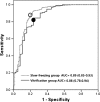Effect of vitrification versus slow freezing of human day 3 embryos on β-hCG levels
- PMID: 24880883
- PMCID: PMC4130934
- DOI: 10.1007/s10815-014-0259-3
Effect of vitrification versus slow freezing of human day 3 embryos on β-hCG levels
Abstract
Purpose: The study was designed to investigate the effect of vitrification and slow freezing for the cryopreservation of human day 3 embryos on serum β-hCG levels in pregnancies established after frozen embryo transfer (FET).
Methods: Of the 1384 FET cycles initiated, 1131 embryo transfers met study criteria and assigned to one of two groups: 797 slow-freezing embryo transfers or 334 vitrified embryo transfers. Median values of β-hCG and outcome of all pregnancies were compared between the two groups. Predictive values of serum β-hCG on day 12 after embryo transfer for establishing ongoing pregnancy and pregnancy failure were determined by receiver operating characteristic (ROC) curve analysis.
Results: In the slow-freezing group, 383 ongoing pregnancies occurred (48.1 %), and transfers of vitrified embryos resulted in 154 pregnancies (46.1 %). Median β-hCG values (279.2 IU/L) for ongoing pregnancies after transfer of vitrified embryos were significantly lower than that of slow frozen embryos (320.5 IU/L). The median values of β-hCG for singleton in the two groups was statistically significant (P <0.05). For slow-freezing embryo transfers, the cut-off value of β-hCG in predicting ongoing pregnancy was 147 IU/L (sensitivity 88.3 %, specificity 80.7 %). For vitrified embryo transfers, the value was 135 IU/L (sensitivity 84.4 %, specificity 76.3 %).
Conclusions: Day 12 β-hCG levels after FET are significantly affected by the methods of embryo cryopreservation for ongoing pregnancies. Furthermore, when using β-hCG cut-off value to assess pregnancy outcome, the cryopreservation methods should be taken into account.
Figures

Similar articles
-
Human chorionic gonadotropin levels are equally predictive for pregnancy outcome after fresh and vitrified-warmed blastocyst transfer.J Assist Reprod Genet. 2013 Nov;30(11):1459-63. doi: 10.1007/s10815-013-0099-6. Epub 2013 Sep 17. J Assist Reprod Genet. 2013. PMID: 24043384 Free PMC article.
-
Higher β-HCG concentrations and higher birthweights ensue from single vitrified embryo transfers.Reprod Biomed Online. 2016 Aug;33(2):149-60. doi: 10.1016/j.rbmo.2016.04.014. Epub 2016 May 10. Reprod Biomed Online. 2016. PMID: 27209497
-
Predictive value of serum HCG concentrations in pregnancies achieved after single fresh or vitrified-warmed blastocyst transfer.Reprod Biomed Online. 2017 Sep;35(3):272-278. doi: 10.1016/j.rbmo.2017.05.011. Epub 2017 May 30. Reprod Biomed Online. 2017. PMID: 28625759
-
Evolution of human oocyte cryopreservation: slow freezing versus vitrification.Curr Opin Endocrinol Diabetes Obes. 2016 Dec;23(6):445-450. doi: 10.1097/MED.0000000000000289. Curr Opin Endocrinol Diabetes Obes. 2016. PMID: 27653002 Review.
-
Vitrification of the human embryo: a more efficient and safer in vitro fertilization treatment.Fertil Steril. 2020 Feb;113(2):241-247. doi: 10.1016/j.fertnstert.2019.12.009. Fertil Steril. 2020. PMID: 32106970 Review.
Cited by
-
The effect of blastomere loss during frozen embryo transfer on the transcriptome of offspring's umbilical cord blood.Mol Biol Rep. 2020 Nov;47(11):8407-8417. doi: 10.1007/s11033-020-05878-6. Epub 2020 Oct 17. Mol Biol Rep. 2020. PMID: 33068229
-
Slow freezing should not be totally substituted by vitrification when applied to day 3 embryo cryopreservation: an analysis of 5613 frozen cycles.J Assist Reprod Genet. 2015 Sep;32(9):1371-7. doi: 10.1007/s10815-015-0545-8. Epub 2015 Aug 4. J Assist Reprod Genet. 2015. PMID: 26238389 Free PMC article.
-
Effect of day 3 embryo morphometrics and morphokinetics on survival and implantation after slow freezing-thawing and after vitrification-warming: a retrospective cohort study.Reprod Biol Endocrinol. 2017 Oct 3;15(1):79. doi: 10.1186/s12958-017-0299-5. Reprod Biol Endocrinol. 2017. PMID: 28974230 Free PMC article.
-
The effect on twinning rate of transferring double vitrified-warmed embryos in women of advanced reproductive age: a retrospective study.PeerJ. 2020 Jan 6;8:e8308. doi: 10.7717/peerj.8308. eCollection 2020. PeerJ. 2020. PMID: 31934507 Free PMC article.
-
Effect of Frozen-Thawed Embryo Transfer on the Metabolism of Children in Early Childhood.J Clin Med. 2023 Mar 16;12(6):2322. doi: 10.3390/jcm12062322. J Clin Med. 2023. PMID: 36983323 Free PMC article.
References
-
- Handschuh K, Guibourdenche J, Tsatsaris V, Guesnon M, Laurendeau I, Evain-Brion D, et al. Human chorionic gonadotropin expression in human trophoblasts from early placenta: comparative study between villous and extravillous trophoblastic cells. Placenta. 2007;28:175–84. doi: 10.1016/j.placenta.2006.01.019. - DOI - PubMed
-
- Stone BA, Vargyas JM, Ringler GE, March CM, Marrs RP. The rate at which serum total beta-subunit human chorionic gonadotropin increases after embryo transfer is a predictor of the viability of pregnancy and an identifier of determinants of pregnancy. Fertil Steril. 2006;86:1626–33. doi: 10.1016/j.fertnstert.2006.04.048. - DOI - PubMed
-
- Zegers-Hochschild F, Altieri E, Fabres C, Fernandez E, Mackenna A, Orihuela P. Predictive value of human chorionic gonadotrophin in the outcome of early pregnancy after in-vitro fertilization and spontaneous conception. Hum Reprod. 1994;9:1550–5. - PubMed
-
- Porat S, Savchev S, Bdolah Y, Hurwitz A, Haimov-Kochman R. Early serum beta-human chorionic gonadotropin in pregnancies after in vitro fertilization: contribution of treatment variables and prediction of long-term pregnancy outcome. Fertil Steril. 2007;88:82–9. doi: 10.1016/j.fertnstert.2006.11.116. - DOI - PubMed
Publication types
MeSH terms
Substances
LinkOut - more resources
Full Text Sources
Other Literature Sources
Medical
Miscellaneous

